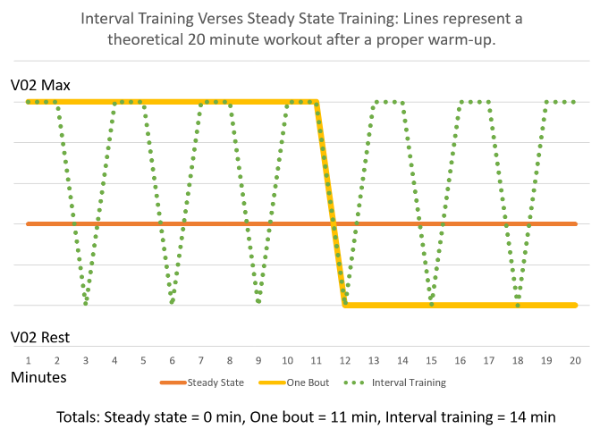Why interval training works
Posted by Adam Stuhlfaut, Director of Running on
High intensity interval training, also known as HIIT, is one of the biggest fitness trends right now. Information on this trend is coming from many sources. Academics are devoting lots of research time. Pop culture fitness marketers, such as Runner World with their HIIT training for runners, are using this trend to market new services. Interval training is defined as rounds of intense bouts of exercise follow by periods of rest/recovery. I have written previously how Interval training has long be lauded by endurance athletes, but we are just starting to learn about why interval training, and particularly HIIT, is so effective in improving many signs of fitness that range from burning fat and toning muscles to making changes on the cellular level. These cellular changes influence changes to V02 max which is one of the most recognized marker of health and fitness.
V02 is a key marker of heath and fitness
One of the most recognized markers of physical fitness is V02 max. V02 max is the measure of how efficient your body is in transferring oxygen rich blood to your cells, and how efficient the cells are at using that oxygen. Recent academic studies show that V02 max is closely linked to a person’s health and fitness. In a previous post where I define V02 max based on the Fick Equation, I mentioned a recent study in Sweden and published in the European Journal of Preventative Cardiology According to a New York Times article about the study, “The study finds that poor physical fitness may be second only to smoking as a risk factor to premature death.” In looking specifically at VO2 (which is the output of the Fick Equation), The New York Times writer points out from the study that “the men in the group with the lowest VO2 max had a 21 percent higher risk of dying prematurely than those with middling aerobic capacity, and about a 42 percent risk of early death than the men who were the most fit.”
Interval training helps to stress V02 max
To improve your V02 max, you must stress your body at your V02 max. This puts stress on the cells to react and change. According to a recent study, when cells are stressed they look to become more able to handle the stress by creating more mitochondria and making the existing mitochondria work harder. Mitochondria are free floating organelles in your cells that make the nutrient breakdown system happen. The more mitochondria a cell has, and the harder they work, the more efficient your cells become.
Interval training helps spend more time stressing V02 max
Because you can only perform at your V02 max for a short time (eight to eleven minutes by many estimates), interval training helps you spend more time at V02 max than during a workout that consists of one bout of all-out effort or steady state cardio. The below graph illustrates how interval training gets you to spend more time at V02 max in a theoretical twenty-minute workout. In this theoretic workout, steady state training typically doesn’t get you to your V02 max. One hard effort gets your there, but leaves you too depleted for more. A controlled interval training allows the body to reach V02 max for many more minutes.

Admittedly, there are many assumptions built into the graph that could be discussed. It is intended to only be a representation of different workout types and the amount of time a V02 max would vary per person for different types of workouts. As always consult with your doctor to make sure you are healthy enough and consult a professional coach to help with workouts.
